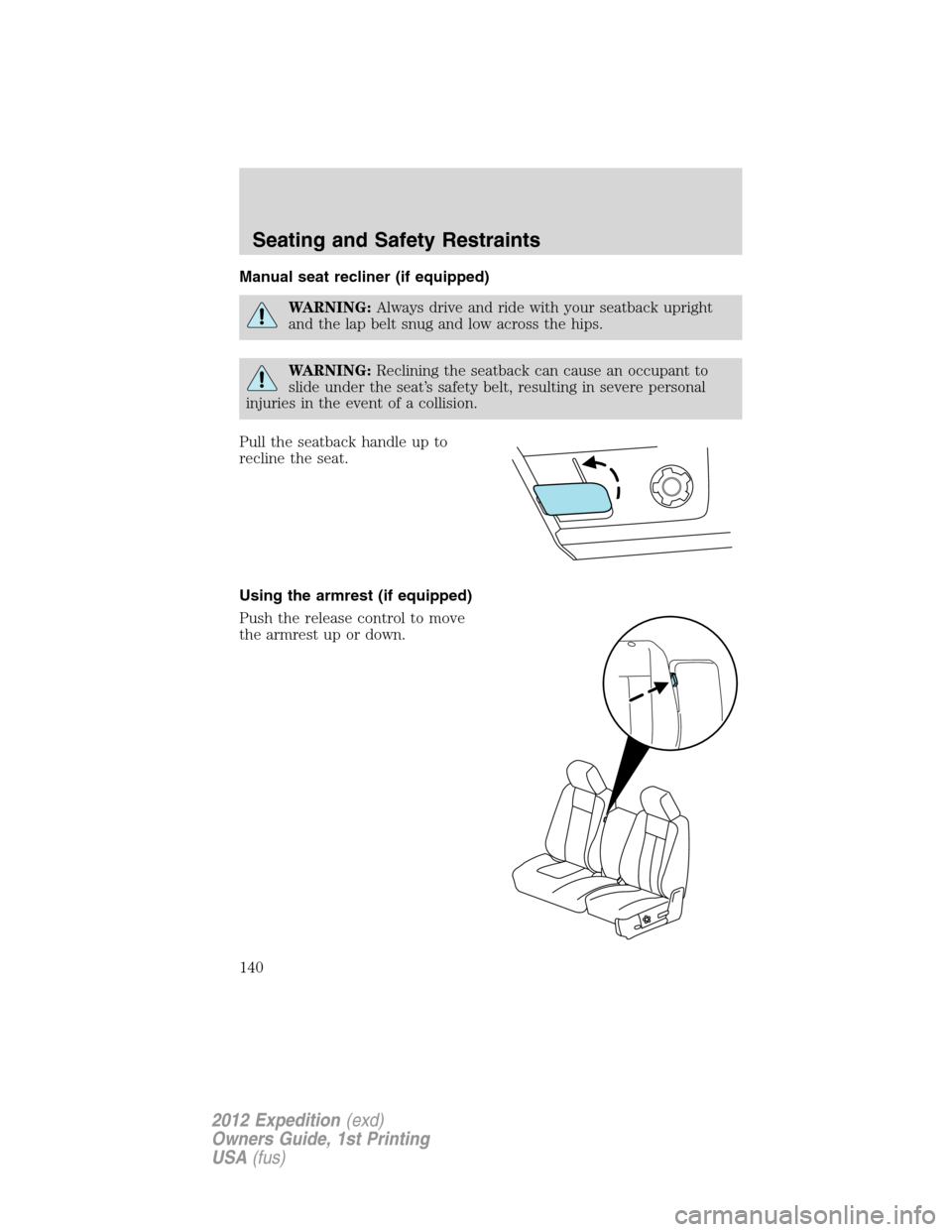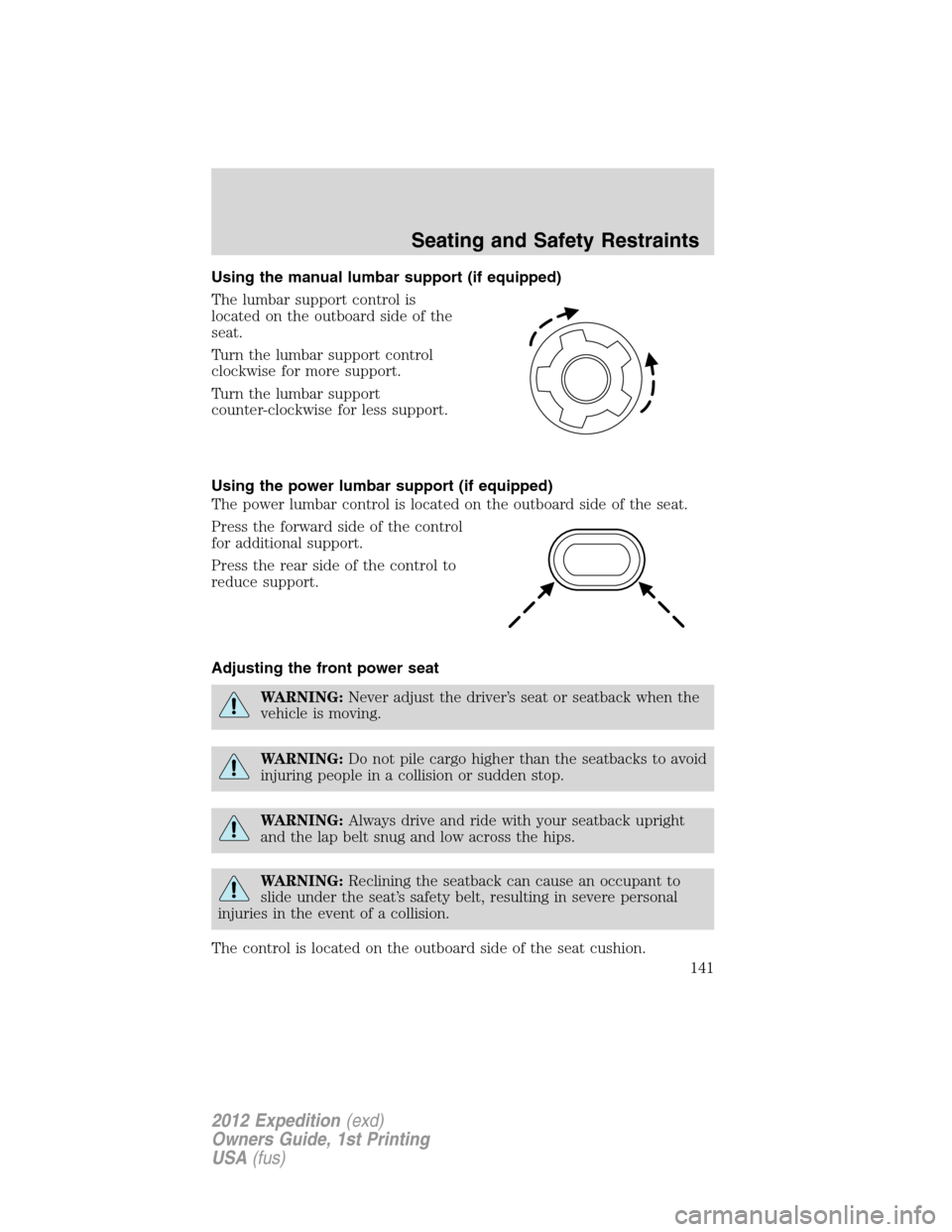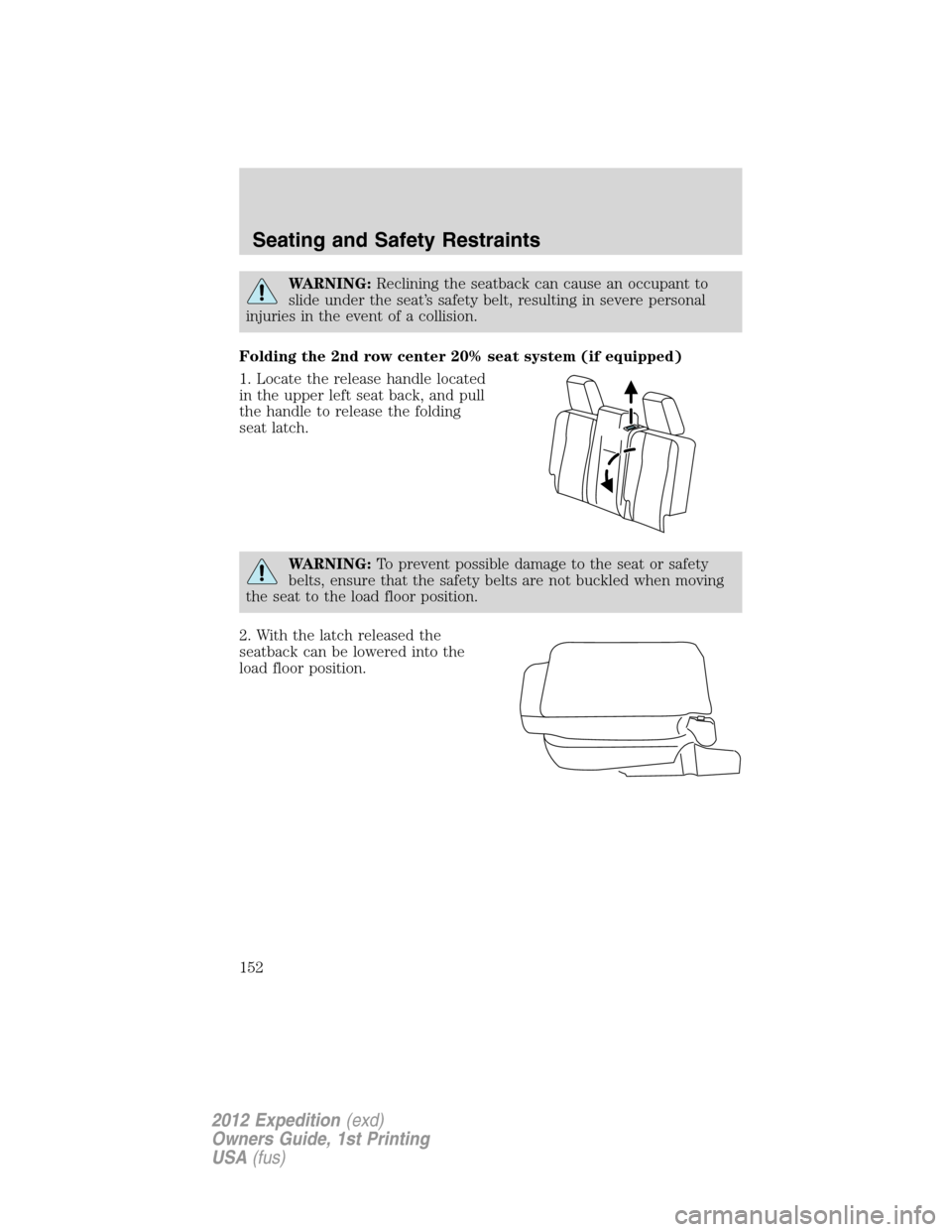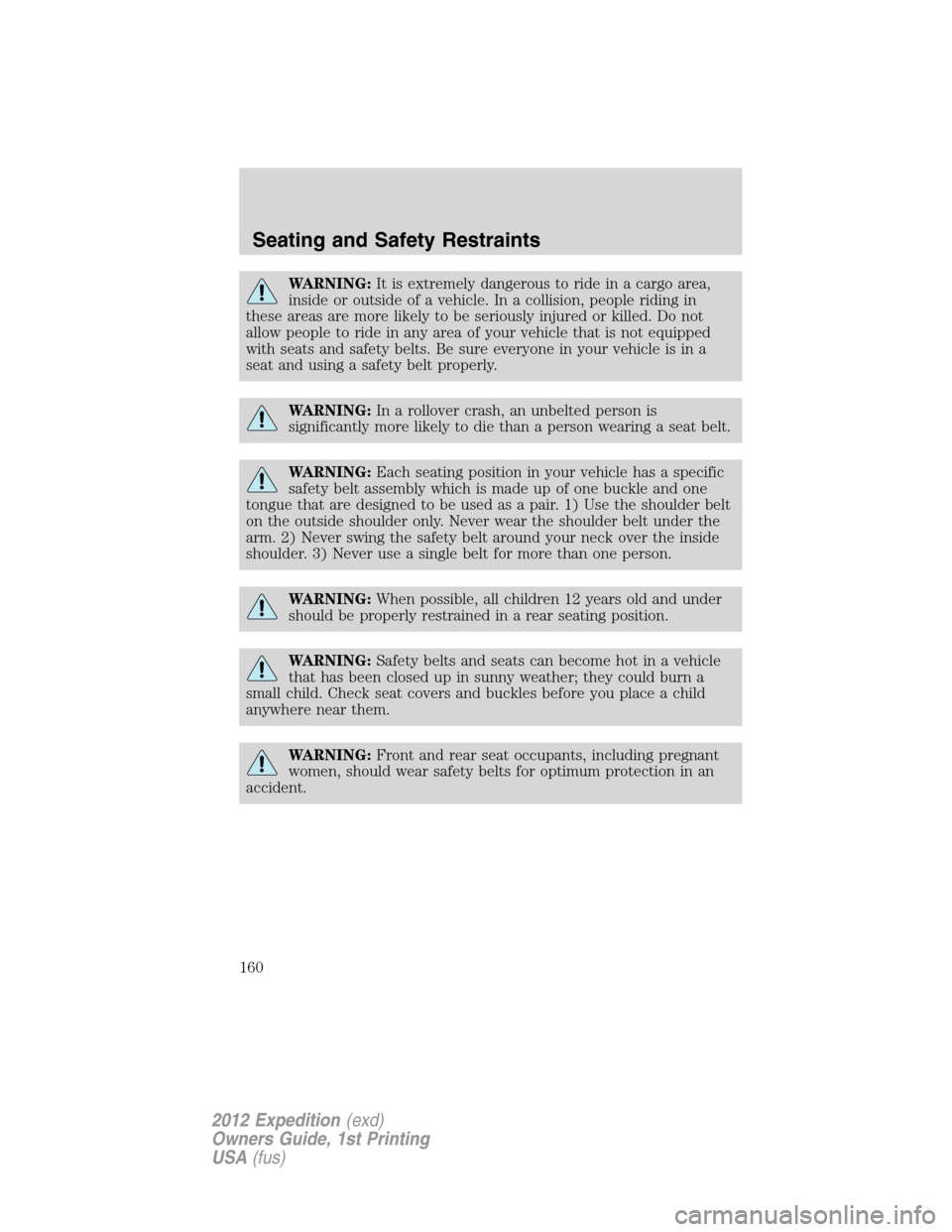2012 FORD EXPEDITION belt
[x] Cancel search: beltPage 140 of 400

Manual seat recliner (if equipped)
WARNING:Always drive and ride with your seatback upright
and the lap belt snug and low across the hips.
WARNING:Reclining the seatback can cause an occupant to
slide under the seat’s safety belt, resulting in severe personal
injuries in the event of a collision.
Pull the seatback handle up to
recline the seat.
Using the armrest (if equipped)
Push the release control to move
the armrest up or down.
Seating and Safety Restraints
140
2012 Expedition(exd)
Owners Guide, 1st Printing
USA(fus)
Page 141 of 400

Using the manual lumbar support (if equipped)
The lumbar support control is
located on the outboard side of the
seat.
Turn the lumbar support control
clockwise for more support.
Turn the lumbar support
counter-clockwise for less support.
Using the power lumbar support (if equipped)
The power lumbar control is located on the outboard side of the seat.
Press the forward side of the control
for additional support.
Press the rear side of the control to
reduce support.
Adjusting the front power seat
WARNING:Never adjust the driver’s seat or seatback when the
vehicle is moving.
WARNING:Do not pile cargo higher than the seatbacks to avoid
injuring people in a collision or sudden stop.
WARNING:Always drive and ride with your seatback upright
and the lap belt snug and low across the hips.
WARNING:Reclining the seatback can cause an occupant to
slide under the seat’s safety belt, resulting in severe personal
injuries in the event of a collision.
The control is located on the outboard side of the seat cushion.
Seating and Safety Restraints
141
2012 Expedition(exd)
Owners Guide, 1st Printing
USA(fus)
Page 152 of 400

WARNING:Reclining the seatback can cause an occupant to
slide under the seat’s safety belt, resulting in severe personal
injuries in the event of a collision.
Folding the 2nd row center 20% seat system (if equipped)
1. Locate the release handle located
in the upper left seat back, and pull
the handle to release the folding
seat latch.
WARNING:To prevent possible damage to the seat or safety
belts, ensure that the safety belts are not buckled when moving
the seat to the load floor position.
2. With the latch released the
seatback can be lowered into the
load floor position.
Seating and Safety Restraints
152
2012 Expedition(exd)
Owners Guide, 1st Printing
USA(fus)
Page 155 of 400

3rd row seats
Ensure that no objects such as books, purses or briefcases are on the
floor in front of the third row seats or on the seat cushion before
lowering them. Ensure that the head restraints are lowered. Ensure that
the second row seats are not reclined.
Folding down the 3rd row seats to the load floor
WARNING:To prevent possible damage to the seat or safety
belts, ensure that the safety belts are not buckled when moving
the seat to the load floor position.
Before folding the third row seats,
fold the head restraints down by
pulling on the strap located at the
bottom of the restraint.
Pull up on the handle located
behind the seatback while pushing
the seatback forward and down into
the seat cushion.
To return the seatback to its original position lift the seatback until it
latches into place.
WARNING:Before returning the seatback to its original position,
make sure that cargo or any objects are not trapped behind the
seatback. After returning the seatback to its original position, pull on the
seatback to ensure that it has fully latched. An unlatched seat may
become dangerous in the event of a sudden stop or collision.
Seating and Safety Restraints
155
2012 Expedition(exd)
Owners Guide, 1st Printing
USA(fus)
Page 157 of 400

RESTRAINT SAFETY SYSTEM
The restraint system provides an improved overall level of frontal crash
protection to front seat occupants and is designed to help further reduce
the risk of airbag-related injuries. The system is able to analyze different
occupant conditions and crash severity before activating the appropriate
safety devices to help better protect a range of occupants in a variety of
frontal crash situations.
Your vehicle’s restraint system consists of:
•Driver and passenger dual-stage airbag supplemental restraints.
•Front safety belts with pretensioners, energy management retractors,
and safety belt usage sensors.
•Driver’s seat position sensor.
•Front crash severity sensor.
•Restraints Control Module (RCM).
•Restraint system warning light and back-up tone.
•The electrical wiring for the airbags, crash sensor(s), safety belt
pretensioners, front safety belt usage sensors, driver seat position
sensor, and indicator lights.
How does the restraint system work?
The restraint system can adapt the deployment strategy of your vehicle’s
safety devices according to crash severity and occupant conditions. A
collection of crash and occupant sensors provides information to the
Restraints Control Module (RCM). During a crash, the RCM may activate
the safety belt pretensioners and/or either one or both stages of the
dual-stage airbag supplemental restraints based on crash severity and
occupant conditions.
The fact that the pretensioners or airbags did not activate for both front
seat occupants in a collision does not mean that something is wrong with
the system. Rather, it means the restraint system determined the
accident conditions (crash severity, belt usage, etc.) were not
appropriate to activate these safety devices. Front airbags are designed
to activate only in frontal and near-frontal collisions, not rollovers,
side-impacts, or rear-impacts unless the collision causes sufficient
longitudinal deceleration.
Seating and Safety Restraints
157
2012 Expedition(exd)
Owners Guide, 1st Printing
USA(fus)
Page 158 of 400

Driver and passenger dual-stage airbag supplemental restraints
The dual-stage airbags offer the capability to tailor the level of airbag
inflation energy. A lower, less forceful energy level is provided for more
common, moderate-severity impacts. A higher energy level is used for
the most severe impacts. Refer toAirbag supplemental restraints
(SRS)section in this chapter.
Front crash severity sensor
The front crash severity sensor enhances the ability to detect the
severity of an impact. Positioned up front, it provides valuable
information early in the crash event on the severity of the impact. This
allows your restraint system to distinguish between different levels of
crash severity and modify the deployment strategy of the dual-stage
airbags and safety belt pretensioners.
Driver’s seat position sensor
The driver’s seat position sensor allows your restraint system to tailor the
deployment level of the driver dual-stage airbag based on seat position.
The system is designed to help protect smaller drivers sitting close to
the driver airbag by providing a lower airbag output level.
Front safety belt usage sensors
The front safety belt usage sensors detect whether or not the driver and
front outboard passenger safety belts are fastened. This information
allows your restraint system to tailor the airbag deployment and safety
belt pretensioner activation depending upon safety belt usage. Refer to
Safety restraintssection in this chapter.
Front safety belt pretensioners
The safety belt pretensioners at the front outboard seating positions are
designed to tighten the safety belts firmly against the occupant’s body
during frontal collisions, and in side collisions and rollovers. This helps
increase the effectiveness of the safety belts. In frontal collisions, the
safety belt pretensioners can be activated alone or, if the collision is of
sufficient severity, together with the front airbags.
Front safety belt energy management retractors
The front outboard safety belt energy management retractors allow
webbing to be pulled out of the retractor in a gradual and controlled
manner in response to the occupant’s forward momentum. This helps
reduce the risk of force-related injuries to the occupant’s chest by
limiting the load on the occupant. Refer toSafety restraintssection in
this chapter.
Seating and Safety Restraints
158
2012 Expedition(exd)
Owners Guide, 1st Printing
USA(fus)
Page 159 of 400

Determining if the restraint system is operational
The restraint system uses a warning light in the instrument cluster or a
back-up tone to indicate the condition of the system. Refer to the
Warning lights and chimessection in theInstrument Clusterchapter.
Routine maintenance of the restraint system is not required.
The Restraints Control Module (RCM) monitors its own internal circuits
and the circuits for the airbag supplemental restraints, crash sensor(s),
safety belt pretensioners, front safety belt buckle sensors, and the driver
seat position sensor. In addition, the RCM also monitors the restraints
warning light in the instrument cluster. A difficulty with the system is
indicated by one or more of the following:
•The warning light will either flash or stay lit.
•The warning light will not illuminate immediately after the ignition is
turned on.
•A series of five beeps will be heard. The tone pattern will repeat
periodically until the problem and warning light are repaired.
If any of these things happen, even intermittently, have the restraint
system serviced at an authorized dealer immediately. Unless serviced, the
system may not function properly in the event of a collision.
SAFETY BELT SYSTEM
WARNING:Always drive and ride with your seatback upright
and the lap belt snug and low across the hips.
WARNING:To reduce the risk of injury, make sure children sit
where they can be properly restrained.
WARNING:Never let a passenger hold a child on his or her lap
while the vehicle is moving. The passenger cannot protect the
child from injury in a collision.
WARNING:All occupants of the vehicle, including the driver,
should always properly wear their safety belts, even when an air
bag supplemental restraint system (SRS) is provided.
Seating and Safety Restraints
159
2012 Expedition(exd)
Owners Guide, 1st Printing
USA(fus)
Page 160 of 400

WARNING:It is extremely dangerous to ride in a cargo area,
inside or outside of a vehicle. In a collision, people riding in
these areas are more likely to be seriously injured or killed. Do not
allow people to ride in any area of your vehicle that is not equipped
with seats and safety belts. Be sure everyone in your vehicle is in a
seat and using a safety belt properly.
WARNING:In a rollover crash, an unbelted person is
significantly more likely to die than a person wearing a seat belt.
WARNING:Each seating position in your vehicle has a specific
safety belt assembly which is made up of one buckle and one
tongue that are designed to be used as a pair. 1) Use the shoulder belt
on the outside shoulder only. Never wear the shoulder belt under the
arm. 2) Never swing the safety belt around your neck over the inside
shoulder. 3) Never use a single belt for more than one person.
WARNING:When possible, all children 12 years old and under
should be properly restrained in a rear seating position.
WARNING:Safety belts and seats can become hot in a vehicle
that has been closed up in sunny weather; they could burn a
small child. Check seat covers and buckles before you place a child
anywhere near them.
WARNING:Front and rear seat occupants, including pregnant
women, should wear safety belts for optimum protection in an
accident.
Seating and Safety Restraints
160
2012 Expedition(exd)
Owners Guide, 1st Printing
USA(fus)